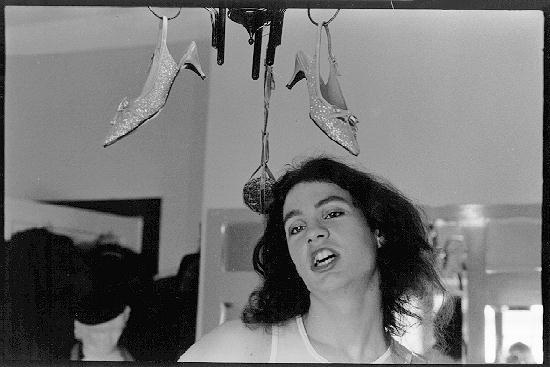All images by Fiona Clark. Diana and Sheila at Mojos nightclub 1975
Advertisement
Bev at Dance Party Auckland, 1974
Fiona Clark: I don't think it was as progressive as people think. I couldn't show the work I did publicly as a collection until 2004. It was as progressive as the homophobia that existed. Within institutions there was homophobia, and that restricted the way people worked. It was a reflection really, and some of it was really hard for me. Galleries told me I was unsellable. Although 42 years later, there is a new interest.Your show Active Eye was infamous and had images removed in 1974. What was it specifically that upset everyone so much?
That it was letting people be visible and saying we're here, we're not going away, we occupy space, accept it. They weren't confrontational—for me they weren't. They were portraits of people I had an affinity with, and who I wanted to record.
Advertisement
From Fiona's 1970s 'Go Girl' Series
Quite often in those days, if you sent something off to a Kodak lab, they censored the work. So I was running a color darkroom as well.With attitudes that ingrained, how did you manage to develop any reputation? As you said, a lot of your work is only now being fully exhibited.
I'm like the people I photographed and hung out with, we're survivors. I just survived it. I admired the tenacity and survival capabilities of those people. They are more hardened than I am. People have lived far tougher lives than me. And I have always had a belief in the work. The work is about survival.

I considered it. I thought of going somewhere and studying—to London to the Royal College of Art. That was the progression from Auckland as an artist. But after the Active Art show I had a prosecution, and I felt pretty beaten up. Galleries were saying, "no you're not showing here." I sort of snuck off to the country. And I still live here, in the same place a snuck off to 40 years ago.Then I had a bad accident so I couldn't go anywhere for a couple of years. But I didn't get any offers of people saying you should show this work somewhere else.
Advertisement
Diana and Peri at miss NZ Drag Ball, 1975
I don't regret not doing it, because I fitted into here, into the community I'd come back to. Unfortunately, not comfortably for a lot of people. But the involvement I have with the community now is on the same level. I'm taking photos of things people aren't recording, and of parts of our community that are still invisible.
Carmen in her Sydney home, 2006
It's something I've accepted. I call myself an activist artist now. I'm not just a photographer, I believe I am an activist. But people don't sit comfortably with that. They certainly don't like the work I've produced so they'll dismiss it. Sometimes it's hard, but I know to just dig my toes in. I've spent this year cataloging my work. I'm more determined now that it lasts even longer.
Miss K, a.k.a. Ella, at home in Auckland, 2001
Yes, I have actually. I live near oil and gas fields, and the local community has gone in front of the local council and said we're upset by this, we want these things changed. I've produced images and said, these are toxic waste sites and they're harming the people who live nearby. The previous mayor challenged me and said, "You can't say that." I said, "I'm not saying it, the image is there. There is a warning sign, but here's a house, all in the image."
Todd Energy flaring after fracking at Mangahewa D well site June 18, 2014
